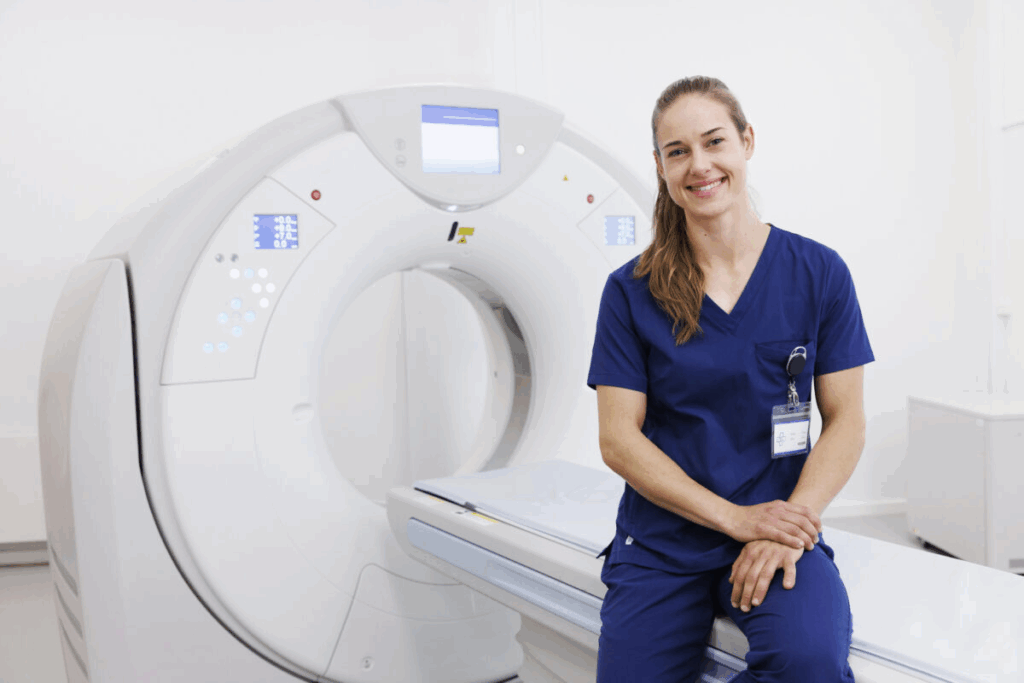Last Updated on November 27, 2025 by Bilal Hasdemir

Nearly 2 million PET scans are done every year in the United States. They help doctors diagnose and treat many health issues. PET scans reveal the activity levels of the body’s cells, helping to identify issues that other tests may overlook.
It’s important to understand PET scan results for both patients and doctors. PET scan images can be complex. They use colors and shades to show how active different parts of the body are. Black areas on a PET scan often mean low activity.
Key Takeaways
- Understanding PET scan results is key for correct diagnosis and treatment.
- Black areas on a PET scan can show low metabolic activity.
- PET scans give valuable insights into the body’s metabolic processes.
- Interpreting PET scan images needs expertise and knowledge of the technology.
- A detailed guide to PET scan interpretation helps patients and doctors make better choices.
Understanding PET Scan Basics

A PET scan, or Positron Emission Tomography scan, is a detailed imaging method. It shows how active the body’s cells are. This tool is key in medicine, helping doctors find and treat many health issues.
What is a PET Scan?
A PET scan uses tiny amounts of radioactive tracers to see how the body works. These tracers are attached to glucose and are taken up by active cells. The PET scanner picks up these signals, making clear images of the body’s inner workings.
How PET Scans Differ from Other Imaging Tests
PET scans are different from CT scans or MRI because they show how active tissues are. This is very useful in finding and treating diseases in areas like the brain, heart, and cancer. It gives doctors a better view of what’s happening inside the body.
By combining PET scans with other imaging, like CT or MRI, doctors get a fuller picture. This helps them make more accurate diagnoses and plan better treatments.
The Science Behind PET Imaging
PET imaging works by detecting the radiation from positrons and electrons meeting. The most common tracer, Fluorodeoxyglucose (FDG), is a sugar molecule with a radioactive atom. Places with lots of sugar uptake show up in the scans, showing where the body is most active.
The PET scanner has detectors that catch these radiation events. It turns them into images that show where the tracer is in the body. This lets doctors see how cells are working, helping them diagnose and research diseases.
The Color Spectrum in PET Scan Images

Understanding the color spectrum in PET scans is key for accurate image interpretation. PET scan images use colors to show different metabolic activity levels in the body. This gives us important diagnostic information.
Standard Color Scales Used in PET Imaging
PET scans use a standard color scale to show metabolic activity intensity. The most common scale is the standardized uptake value (SUV) scale. It measures the radioactive tracer uptake in tissues compared to the body’s average uptake.
The SUV scale uses a color gradient. It goes from black or blue for low uptake to red or white for high uptake. This makes it easy to see metabolic activity levels quickly.
What Different Colors Represent
In PET scan images, colors show different metabolic activity levels. Black or dark blue areas mean low metabolic activity. Red or white areas show high metabolic activity.
- Black or Blue: Low metabolic activity or no significant tracer uptake.
- Green or Yellow: Moderate metabolic activity, seen in normal tissues or mild inflammation.
- Red or White: High metabolic activity, indicating high glucose uptake, like in tumors or inflammation.
A leading radiologist notes,
“The color spectrum in PET scans is a powerful tool for diagnosing and monitoring various conditions, from cancer to neurological disorders.”
The Significance of Color Intensity
The color intensity in PET scan images shows metabolic activity level. Higher intensity colors mean more metabolic activity. Lower intensity colors show less activity.
Knowing the color intensity is key for accurate PET scan interpretation. It helps spot abnormal metabolic activity. This can point to different diseases.
What Does Black Mean on a PET Scan?
Black areas on a PET scan can be confusing. But knowing what they mean is important for understanding the scan. PET scans show different colors for different body activities. Black usually means little or no activity.
Interpreting Black Regions in PET Images
When you see black in PET images, think about the scan’s context and the area being looked at. Black can mean low activity in some tissues or organs. It can also mean no tracer uptake in the scan.
Low metabolic activity is normal in some tissues like fat or muscle. But it can also mean a problem where activity is lower than usual.
Low Metabolic Activity vs. No Activity
Telling low activity from no activity is key for correct scan interpretation. Both might look black, but the reasons are different. Low activity might be normal or in tissues with naturally lower rates.
Clinical context is important for this. For example, in cancer, a black area in a tumor might mean treatment worked. Or it could mean there are no live tumor cells, which needs more checking.
Normal vs. Abnormal Black Areas
Figuring out if black areas are normal or not needs knowing what’s usual and the patient’s situation. Some organs, like the liver or spleen, can show different levels of activity. What’s normal can change.
- Normal black areas might be in areas with naturally low activity.
- Abnormal black areas could mean a problem, like necrosis or low activity where it’s expected.
Understanding black areas on a PET scan is complex. It needs expertise and looking at all the information and other scans.
How to Read a PET Scan
Reading a PET scan requires careful preparation and attention to detail. It’s important to know the basics of PET imaging technology. This knowledge helps in understanding the information it provides.
Preparing to Review PET Images
Before starting to interpret PET scans, gather all relevant clinical information. It’s also important to understand the patient’s medical history. This preparation includes:
- Reviewing the patient’s medical records and previous imaging studies
- Understanding the clinical question being addressed by the PET scan
- Familiarizing oneself with the PET scan protocol used
Knowing the patient’s condition and the scan details is key for accurate interpretation.
Systematic Approach to Scan Interpretation
When analyzing PET scan images, a systematic approach is essential. This involves:
- Evaluating the overall image quality and identifying any artifacts
- Assessing the distribution of the radiotracer throughout the body
- Focusing on areas of abnormal uptake or unusual patterns
By following a structured method, interpreters can ensure they consider all relevant information. This reduces the chance of missing critical findings.
Identifying Key Anatomical Landmarks
Identifying key anatomical landmarks is a critical step in PET scan interpretation. It’s important to recognize normal structures and their typical metabolic activity patterns. Key landmarks include:
- The brain, with its characteristic metabolic activity
- The heart, which may show variable uptake depending on the radiotracer used
- Major organs like the liver, spleen, and kidneys, which have distinct patterns of radiotracer uptake
Understanding these landmarks helps in distinguishing between normal and abnormal findings. This enhances the accuracy of the interpretation.
By combining a systematic approach with a thorough understanding of anatomical landmarks and metabolic patterns, healthcare professionals can effectively read PET scans. This provides valuable insights for patient care.
Understanding SUV Values in PET Scan Interpretation
Getting a PET scan right means knowing SUV values well. SUV, or Standardized Uptake Value, shows how much tracer a tissue takes up. It’s key for PET scans.
What is Standardized Uptake Value (SUV)?
Standardized Uptake Value (SUV) checks how much tracer a spot takes in. It’s the activity in a spot divided by the dose and body weight. SUV values tell us about metabolic activity. They help doctors tell if something is normal or not.
How SUV Relates to Image Colors
PET images use colors based on SUV values. Warmer colors mean higher SUV values and more activity. Cooler colors show less activity. Knowing this helps doctors read PET scans right.
Normal SUV Ranges vs. Concerning Values
What’s normal for SUV values changes with the tissue and tracer. Low SUV values usually mean normal or benign tissues. But, high SUV values might show cancer or high activity. It’s important to look at the whole picture, not just SUV values.
In cancer scans, high SUV values can raise red flags. But, low values might mean the tissue is not active or is dying.
Common Patterns and Findings in PET Scans
Understanding PET scans is key to diagnosing and treating patients. Healthcare experts look for normal and abnormal patterns in these scans. This helps them figure out what’s going on inside the body.
Normal Physiological Uptake Patterns
Healthy tissues and organs show normal patterns on PET scans. For example, the brain is very active and shows up bright. The heart, liver, and kidneys also show different levels of activity based on the tracer and the person’s health.
Common areas of normal uptake include:
- The brain, due to its high glucose demand
- The heart, when using certain tracers
- The liver and kidneys, involved in metabolizing and excreting the tracer
- The urinary tract, as the tracer is excreted in the urine
Pathological Uptake Patterns
Disease shows up as abnormal patterns on PET scans. For instance, tumors often have high glucose uptake, making them stand out. This is because they are very active metabolically.
Examples of pathological uptake include:
- Increased uptake in tumors, indicating high metabolic activity
- Decreased uptake in areas of necrosis or scar tissue
- Altered patterns in neurological disorders, such as Alzheimer’s disease
Distinguishing Normal Variants from Disease
It’s tricky to tell normal variations from disease in PET scans. Experts need to know the body’s normal functions and common variations. This helps them make accurate diagnoses.
Key factors to consider include:
- The patient’s clinical history and symptoms
- The type of tracer used and its distribution
- Comparison with other imaging modalities, such as CT or MRI
By analyzing these factors and recognizing patterns, doctors can accurately read PET scans. This helps them give better care to their patients.
Clinical Significance of Black Areas in Different Conditions
Black areas on PET scans are more than just missing color. They carry important information that affects patient care. Understanding these areas requires knowing about metabolic activity and its clinical meaning.
Cancer Imaging
In cancer care, black spots on PET scans often mean low or no metabolic activity. This is important for several reasons:
- Non-viable tumors: Black spots in tumors might show that parts are not active, which could mean treatment is working.
- Necrosis: Black spots can also show necrotic tissue, which is common in fast-growing tumors.
- Treatment response: More black spots in a tumor after treatment can be a positive sign, showing the treatment is effective.
Neurological Disorders
In neurology, black spots on PET scans mean different things depending on the condition:
- Neurodegenerative diseases: In diseases like Alzheimer’s, black spots show areas with low activity, helping to measure disease severity.
- Brain tumors: Like in cancer, black spots in brain tumors can show necrosis or how well the tumor is responding to treatment.
- Seizure disorders: PET scans can spot abnormal brain activity, with black spots possibly showing low activity between seizures.
Cardiac Assessment
In cardiology, PET scans check for heart viability and blood flow:
- Myocardial viability: Black spots on a heart PET scan can show non-viable heart muscle, which is key for deciding on heart procedures.
- Perfusion defects: Black spots can also show areas with low blood flow, aiding in diagnosing and treating heart disease.
Knowing the meaning of black areas on PET scans in various medical fields is vital for accurate diagnosis and treatment. By understanding these areas in the context of a patient’s overall health, doctors can make better decisions.
PET Scan Interpretation in Oncology
In oncology, PET scans are key for making treatment decisions and caring for patients. They show how tumors work by looking at their metabolic activity. This is important for seeing how far the disease has spread and how well it’s responding to treatment.
Cancer Detection and Staging
PET scans are essential for finding cancer and figuring out its stage. They highlight areas where tumors are active, helping doctors find primary tumors and spread. This helps choose the best treatment.
But, PET scans can also have false positives or negatives. For example, some inflammatory conditions can look like cancer because they’re active too.
Monitoring Treatment Response
PET scans are great for checking if a tumor is responding to treatment. They watch how metabolic activity changes over time. This tells doctors if the treatment is working or if they need to try something else.
This is really important in personalized medicine. It lets doctors adjust treatments based on how a patient reacts. This can lead to better results.
Recurrence Evaluation
PET scans also help find cancer that comes back after treatment. They can spot changes before they show up in other tests. This is key for catching recurrence early and improving treatment outcomes.
In short, understanding PET scans in oncology is complex. It’s not just about the scans themselves but using them to make better treatment choices. By using PET scans for detection, staging, monitoring, and finding recurrence, doctors can give patients more tailored and effective care.
PET Scan Reading in Neurology
PET scans are key in neurology, showing how the brain works. They help doctors see brain activity. This helps them understand and treat many brain conditions.
Brain Metabolism Patterns
PET scans show brain health by looking at how it uses energy. Active brain parts, like the cerebral cortex, take up more tracer. Less active parts, like white matter, take up less.
Abnormal patterns can mean trouble. For example, low activity might show brain damage or disease.
Alzheimer’s and Dementia Evaluation
PET scans are great for checking Alzheimer’s and dementia. They spot changes in brain activity that show these diseases. This helps doctors understand the brain’s health better.
Tracers like Florbetapir help find amyloid plaques. These are key signs of Alzheimer’s.
Seizure Focus Localization
PET scans help find where seizures start in epilepsy. They show areas that are less active. This helps doctors plan surgery or other treatments.
- Identifying areas of hypometabolism
- Correlating PET findings with EEG and other diagnostic data
- Guiding surgical or therapeutic decisions
Potential Pitfalls and Artifacts in PET Scan Reading
Reading PET scans accurately means knowing about common problems and artifacts. These can mess with image quality and how well we can diagnose. It’s a detailed job that needs careful attention and a good grasp of what can go wrong.
Common Technical Artifacts
Technical issues in PET scans come from many places. This includes broken equipment, software bugs, and mistakes when taking the scan. Some common problems are:
- Motion artifacts: If the patient moves during the scan, images can get blurry or off-center.
- Attenuation artifacts: Things like metal can block the PET signal, causing problems.
- Truncation artifacts: When the scanner can’t see the whole body or organ, it misses parts.
Patient-Related Factors Affecting Interpretation
Things about the patient can also mess with how we read PET scans. These include:
- Physiological variations: Sometimes, normal body processes can look like disease.
- Patient preparation: Not following instructions, like not fasting, can hurt image quality.
- Body composition: Being overweight can change how images look and affect SUV values.
How to Distinguish Artifacts from Pathology
It’s key to tell real disease from scan problems. Here’s how:
- Matching PET scan results with CT or MRI images.
- Using what we know about the patient to help make sense of the scan.
- Using special image processing to fix or lessen scan issues.
Knowing about these issues helps doctors get better at reading PET scans. This leads to better care for patients.
Advanced PET Scan Interpretation Techniques
Advanced techniques are changing how PET scans are read in clinics. These new methods make diagnoses more accurate and help patients get better care. Let’s look at some of these advanced techniques used in PET scan reading.
Dual-Time-Point Imaging
Dual-time-point imaging is a new PET method. It takes pictures at two times after the tracer is given. This helps tell if a lesion is cancer or not by looking at its activity over time.
Key benefits of dual-time-point imaging include:
- Improved detection of malignant tumors
- Better differentiation between cancerous and non-cancerous lesions
- Enhanced assessment of treatment response
PET/CT and PET/MRI Fusion Interpretation
PET scans combined with CT or MRI have changed how we diagnose. PET/CT and PET/MRI fusion helps pinpoint where metabolic activity is in the body.
The advantages of fusion imaging include:
- Accurate anatomical localization of PET findings
- Improved characterization of lesions
- Enhanced detection of small or complex lesions
Quantitative Analysis Methods
Quantitative analysis of PET scans measures metabolic activity. Standardized Uptake Value (SUV) is a key metric used.
Quantitative analysis methods offer several benefits:
- Objective assessment of disease severity
- Monitoring of treatment response
- Improved prognostication
By using these advanced techniques, doctors can make more accurate diagnoses. This leads to better treatment plans for patients.
Working with Your Doctor to Understand PET Scan Results
PET scan results can be complex. Working with your healthcare provider is key to understanding them. When you get your PET scan results, you might have questions and concerns. Your doctor is there to help you understand the findings and decide what to do next.
Questions to Ask About Your PET Scan
To get the most out of your consultation, prepare a list of questions. Ask about the overall impression of your PET scan results. Also, ask about any abnormalities and how they relate to your symptoms or condition.
You might also want to ask about the Standardized Uptake Value (SUV). This can help you understand your specific case better.
- What do the results indicate about my condition?
- Are there any areas of concern that need further investigation?
- How do the PET scan findings align with my symptoms?
- What are the next steps in my diagnosis or treatment plan?
Understanding the Radiologist’s Report
The radiologist’s report is a detailed document about your PET scan. It describes the images, any notable features or abnormalities, and sometimes recommends further testing or treatment. Your doctor will help you understand this report, explaining the key points and their implications for your care.
It’s essential to understand that the radiologist’s report is not a diagnosis but a tool to aid in diagnosis and treatment planning.
Follow-up Recommendations Based on Findings
Depending on your PET scan results, your doctor may recommend additional tests, procedures, or treatments. These recommendations are tailored to your specific condition and overall health. It’s important to follow your doctor’s advice and ask questions if you’re unsure about any aspect of your follow-up care.
By working closely with your healthcare provider and asking the right questions, you can gain a clearer understanding of your PET scan results. This will help you address your health concerns effectively.
Conclusion
Understanding PET scan results is key for accurate diagnosis and treatment. This guide covered the basics of PET scan interpretation. It also talked about the importance of black areas on PET scans.
By learning about PET scan interpretation, patients and doctors can make better decisions. It’s important to know what’s normal and what’s not. This helps in telling apart harmless and harmful conditions.
Knowing how to interpret PET scans helps people deal with its complexities. It lets patients be more involved in their health care. They can ask better questions and seek more information when needed.
To read a PET scan well, consider the clinical context, SUV values, and image details. This approach helps doctors give accurate diagnoses and plan effective treatments.
Following this guide helps people understand PET scan interpretation better. It makes the most of this important diagnostic tool.
FAQ
What is a PET scan, and how does it work?
A PET (Positron Emission Tomography) scan is a medical test. It uses a small amount of radioactive tracer to see how the body works. It detects energy from the tracer to make detailed images of the body’s structures and functions.
What do different colors on a PET scan represent?
The colors on a PET scan show different metabolic activities. Red and yellow mean high activity, while blue and black mean low. The exact meaning depends on the color scale used.
What does black mean on a PET scan?
Black on a PET scan usually means low or no activity. This can be normal in some areas or could show a problem like tissue damage or a cyst.
How do I interpret SUV values on a PET scan?
SUV (Standardized Uptake Value) measures how much tracer is taken up. Higher values mean more activity. Normal ranges vary by tissue and tracer. Your doctor can explain what your SUV values mean.
Can PET scans be used for cancer diagnosis and monitoring?
Yes, PET scans are used to find, stage, and track cancer. They show how active tumors are, helping doctors decide on treatment.
What are some common pitfalls in interpreting PET scans?
Common mistakes include technical issues, patient movement, and confusing normal findings with disease. Radiologists use strategies to avoid these errors.
How can I work effectively with my healthcare provider to understand my PET scan results?
To understand your PET scan, ask your doctor about the findings and SUV values. Knowing the radiologist’s report and follow-up plans helps with your care.
Are there advanced techniques in PET scan interpretation?
Yes, there are advanced methods like dual-time-point imaging and PET/CT fusion. These provide more detailed information for complex cases.
Can PET scans be used in neurology?
Yes, PET scans help in neurology by showing brain metabolism. They help diagnose Alzheimer’s, dementia, and find seizure foci, giving insights into neurological conditions.
How do I prepare to review PET images?
To review PET images, know the patient’s history and the scan’s purpose. A systematic approach, including identifying landmarks, is key.
Reference
- Hofman, M. S., & Hicks, R. J. (2016). How We Read Oncologic FDG PET/CT. Seminars in Nuclear Medicine, 46(4), 225–233. https://www.ncbi.nlm.nih.gov/pmc/articles/PMC5067887/






